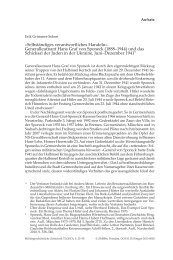Jewish Consumption and Material Culture in the Early Modern Period
Jewish Consumption and Material Culture in the Early Modern Period
Jewish Consumption and Material Culture in the Early Modern Period
Create successful ePaper yourself
Turn your PDF publications into a flip-book with our unique Google optimized e-Paper software.
Workshop Program<br />
“<strong>Jewish</strong> <strong>Consumption</strong> <strong>and</strong> <strong>Material</strong> <strong>Culture</strong> <strong>in</strong> <strong>the</strong> <strong>Early</strong> <strong>Modern</strong> <strong>Period</strong>”<br />
Sunday, August 19, 2007,<br />
5pm Reception at <strong>the</strong> University of Maryl<strong>and</strong><br />
6 pm Keynote Address: Paula F<strong>in</strong>dlen, Stanford University, "Possessions: The <strong>Material</strong><br />
<strong>Culture</strong> of <strong>Early</strong> <strong>Modern</strong> Italy"<br />
The keynote address will use <strong>the</strong> question of collect<strong>in</strong>g objects <strong>in</strong> early modern Italy to<br />
discuss <strong>the</strong> broader context of o<strong>the</strong>r k<strong>in</strong>ds of possessions <strong>and</strong> recent trends <strong>in</strong> explor<strong>in</strong>g<br />
material culture.<br />
Monday, August 20, 2007<br />
Morn<strong>in</strong>g:<br />
9:30-10:40 Shalom Sabar, The Image of <strong>the</strong> <strong>Jewish</strong> Wedd<strong>in</strong>g <strong>in</strong> <strong>the</strong> Works of Eighteenth<br />
Century German Hebraists (Page 7)<br />
A relatively considerable number of images perta<strong>in</strong><strong>in</strong>g to <strong>the</strong> <strong>Jewish</strong> wedd<strong>in</strong>g survived<br />
from medieval to early modern Germany. These are to be found <strong>in</strong> Hebrew illum<strong>in</strong>ated<br />
manuscripts, illustrated books of customs (M<strong>in</strong>hagim-Bücher), decorated Torah b<strong>in</strong>ders<br />
(Wimpeln), <strong>and</strong> selected wedd<strong>in</strong>g artifacts. However, <strong>the</strong> most captivat<strong>in</strong>g <strong>and</strong> curious<br />
visual evidence on <strong>the</strong> various stages <strong>and</strong> customs of <strong>the</strong> <strong>Jewish</strong> wedd<strong>in</strong>g <strong>in</strong> Germany is<br />
not found <strong>in</strong> <strong>Jewish</strong> sources but <strong>in</strong> <strong>the</strong> work of eighteenth century Christian Hebraists.<br />
Despite <strong>the</strong> clear anti-Semitic overtones <strong>in</strong> <strong>the</strong>ir work, <strong>the</strong> images <strong>in</strong>serted <strong>in</strong> <strong>the</strong>ir books<br />
provide rare <strong>and</strong> significant <strong>in</strong>sights <strong>in</strong>to <strong>Jewish</strong> practices, folk beliefs <strong>and</strong> traditions,<br />
<strong>in</strong>terior views <strong>and</strong> <strong>in</strong>timate moments, <strong>and</strong> o<strong>the</strong>r rare glimpses <strong>in</strong>to <strong>Jewish</strong> life <strong>in</strong><br />
contemporary Germany.<br />
10:40-10:50 COFFEE BREAK<br />
10:50-12 Limor M<strong>in</strong>tz-Manor, The Phoenix, <strong>the</strong> Exodus <strong>and</strong> <strong>the</strong> Temple - Construction of<br />
Self Identity <strong>in</strong> <strong>the</strong> Sephardic <strong>Jewish</strong> Congregation of Amsterdam <strong>in</strong> <strong>the</strong> <strong>Early</strong> <strong>Modern</strong><br />
<strong>Period</strong> (Page 16)<br />
My presentation <strong>in</strong>vestigates <strong>the</strong> symbols of <strong>the</strong> Sephardic congregation <strong>in</strong> Amsterdam,<br />
ma<strong>in</strong>ly <strong>the</strong> Phoenix <strong>and</strong> <strong>the</strong> Pelican that symbolize <strong>the</strong> resurrection of Jesus <strong>in</strong> catholic<br />
Christianity, alongside <strong>the</strong> unique exegesis by several congregants of <strong>the</strong> Exodus<br />
narrative. The analysis of <strong>the</strong> symbols, images <strong>and</strong> <strong>the</strong> architecture of <strong>the</strong> congregation's<br />
2



